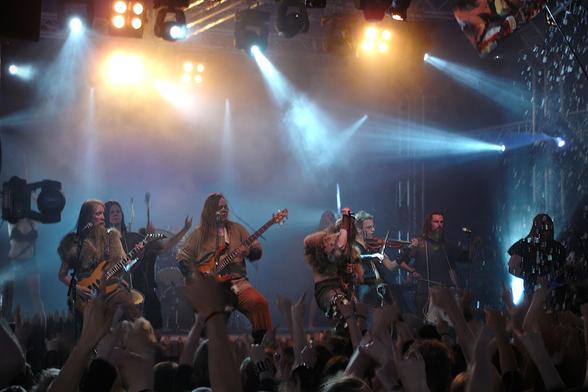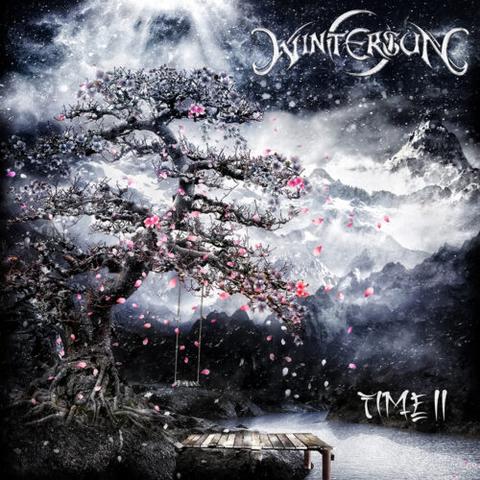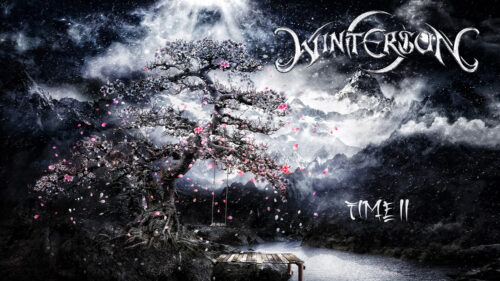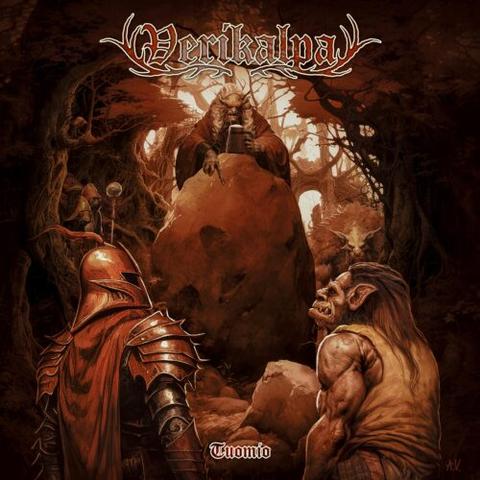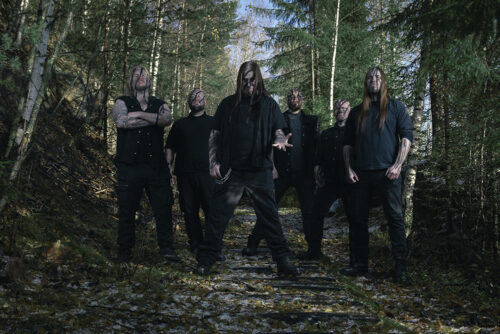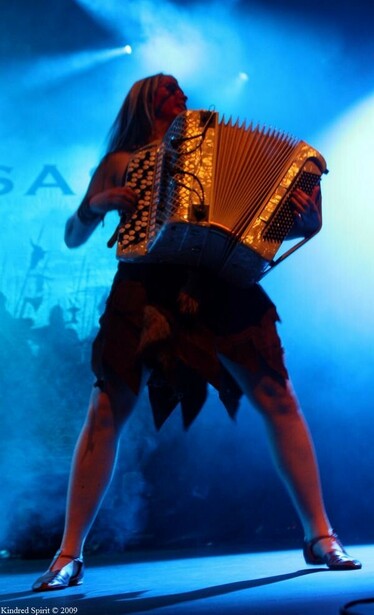#Turisas
By Angry Metal Guy
Wintersun’s Time II has finally been released after 12 long years. Originally announced before the release of Time I, the album was soon delayed due to mainman Jari Mäenpää’s apparent dissatisfaction with the sound. Enough ink has been spilled on the drama surrounding Jari and his surprisingly stable band—I had not realized that Wintersun has Nightwish’s rhythm section in Kai Hahto on drums and Jukka Koskinen on bass, while guitarist Teemu Mäntysaari is now in Megadeth and, more importantly, contributed guitar solos to the legendary Hevisaurus—and, frankly, it isn’t relevant whether his home studio has a sauna or whatever. What’s more relevant is whether the 12-year wait was worth it. Is Time II a good record? Were the fundraisers and jokes about quantum computing worth it? And like Time II, those questions are simultaneously simple and complicated.
At its root, Wintersun is best understood as a melodic black metal band. Rooted in the wave of Scandinavian melodic blackened/death metal that arose in the early 2000s, Wintersun’s sound is still strongly reminiscent of that which went before, bands like Ensiferum, Månegarm, Thyrfing, and Turisas. This sound’s root is Hahto’s double kick and his ferocious blast beats. These are topped by trem-picked melodies, often in harmonic minor, and topped with guitar godly solos from two of Finland’s finest shredders.1 Floating on the surface comes Jari’s screams and cleans. His screams, again, exist in the melodic black and death space from the early 2000s, while his cleans verge on power metal. His gritty voice plays a major role in Wintersun sounding like Wintersun, as he has a unique approach to both how he produces his vocals and the melodies he sings. Like many bands of this era, the tendency towards maximalism in presentation means that the bass sits low in the mix and often goes unremarked if you aren’t specifically looking for it. And if maximalism isn’t Jari Mäenpää’s middle name, then it’s the meaning of his last name.
Time II is primarily made up of four through-composed songs that run between 6 and 13 minutes. A through-composed song is something like Weird Al’s “Biggest Ball of Twine in Minnesota,”2 where the song doesn’t have a verse-chorus structure in a traditional sense, but rather there will be melodies and chord progressions that resurface, often varying on a second or third introduction. While arguably common in modern metal writing, rarely have I felt the need to mention it3. In the case of Time II, however, this is precisely what makes it such an interesting departure from Wintersun’s debut and, as well, what makes it an album that’s difficult to wrap your mind around. Each of these songs—”The Way of the Fire,” “One with the Shadows,” “Storm,” and “Silver Leaves”—feature a couple of primary progressions around which the song hovers. The first progression usually introduces a theme that will be repeated, while the second is a kind of refrain that the song will double back on. Yet each song morphs and twists, feeling simultaneously repetitive and novel—leaving the listener with the impression of an A-B-A structure that doesn’t exist and waiting for whistleable melodies that might not resurface.
There is a subtle ingenuity to Jari’s compositional approach that feels inspired by classical music. Each song modulates, with melodies floating on top of the undulating rhythm, while ideas seem fleeting; surfacing before falling away under moist keyboard textures. While Opeth once said that we should view their songs like “movements,” not “songs,” Wintersun writes like that’s the case. And the result for a listener can feel dreamy and sometimes disorienting, waiting for a theme to be repeated where it will never be. This is emphasized by a maximalist production job that even at a DR7/8 feels like every square millimeter of audio retail is taken up by something. This creates a big sound with a lot of moving parts and unlike “Biggest Ball of Twine in Minnesota,” nothing snaps the listener back into place and reorients them.
The real brilliance of Time II, however, shines through the guitar work. Moreso than the composition or the production—which, honestly, would have benefited from someone like Jens Bogren who has conquered the question of how best to produce big, orchestral metal—the guitars are where the real dynamics arise. This is clearest, for me, in the way that “Ominous Clouds” feeds from the plodding, mid-paced “One with the Shadows” and into “Storm.” With pristine form and beautiful tone, the song sounds like how I imagine David Gilmour would have sounded if he played like Yngwie Malmsteen. The underlying keys exist only to pad these lances of sound that explode from Jari’s incredible fingers. This feeds into Dimmu Borgirian orchestral hits and the primary theme from “Storm,” where the chord progression around which the song will modulate is introduced. But again, the first real change arrives at the 4:50 mark where the guitar suddenly leads the song into a different place! Here we see the kind of compositional brilliance that isn’t just a song rotating around an A and B part, but rather that changes the feel, modulates the vibe, and feeds back into a majestic and beautiful refrain.
The juxtaposition of brilliant, adventurous guitar solos with busy, but simple, musical ideas may be Time II’s biggest weakness. While the use of Chinese instrumental samples and melodies on tracks like “Silver Leaves” or “One with the Shadows” adds a beautiful character to the album, I am struck by how thin and unadventurous the whole feels compositionally. There’s something strange about the fact that this album, so grandiose and for which fans have waited so long, seems to rest on a flimsy and unclear concept. Unlike Ayreon’s The Theory of Everything, which does many of the same things, there’s no sense that Jari wants to repeat themes outside of any given specific song. There are no bigger conceptual interconnections between Time I and Time II that I have noticed. Instead, “Silver Leaves” reaches nearly eight minutes modulating around a singular idea, before introducing a counter melody. “One with the Shadows” is vehemently repetitive, with even the guitar solos not being allowed to drive the song off its monorail of a chord progression.
Time II is an album that is brilliant in some ways and sometimes disorienting. Like a Transformers movie, it is sometimes extremely entertaining to watch, but after you’ve seen it you’re just not sure that you really remember it. With repetition, I have come to love and appreciate these songs. I would even say that Time II is my favorite Wintersun record and it features Jari’s guitarwork at its absolute pinnacle; the man should be a legend for some of these solos. But for an album with such scope and fanfare and vitriol from the fanbase, it seems oddly limited now that it’s finally here. In the end, It’s really good. I particularly love “Storm” and “The Way of the Fire,” even if I’m less in love with “Silver Leaves” and “One with the Shadows.” I would love to see Jari drawing from the Michael Romeo playbook in the future of playing more with tempo, time signatures, and feel, varying his compositions in ways that feel surprising or, alternately, trying to link them together into an epic concept record that works thematically like a John Williams composition. But, if you like melodic black metal with incredible guitars and a lot of energy, Time II is the best thing Jari’s done since Ensiferum. I just can’t help but feel like that’s an anticlimax.
Rating: Really Good!
DR: 7 | Format Reviewed: V0 MP3
Label: Nuclear Blast Records
Websites: wintersun.bandcamp.com | facebook.com/wintersun | patreon.com/wintersun
Released Worldwide: August 30th, 2024
#2024 #30 #Aug24 #Camel #Ensiferum #Hevisaurus #JensBogren #Månegarm #Megadeth #MelodicBlackMetal #MelodicDeathMetal #Nightwish #Opeth #Queen #Review #Reviews #Thyrfing #TimeI #Turisas #WeirdAlYankovic #Wintersun
By Angry Metal Guy
Tuomio is the fourth full-length LP from Finnish extreme folk metallers, Verikalpa. Back in ’20,1 I reviewed—and thoroughly enjoyed—Verikalpa’s sophomore platter Tuoppitannsi. The thing that stood out to me about the record, and its follow-up Tunturihauta, was how much it felt like the band was carrying forward the impeccable vibes from Finntroll’s earliest contributions, but without setting their stamp on it. Still, the writing popped and the sound satisfyingly scratched an extremely specific itch. As I wrote at the time, they bore “the accordion of tradition to the sauna of the metal gods, so that we might have something new to listen to while we drink.” But, let’s be honest, “competent but derivative” is not the praise anyone is looking for when they create music. And so one wonders, four years after my initial exposure, is that the only contribution Verikalpa had to make?
Like its predecessors, Tuomio has a familiar sound that’s easy to love. Verikalpa plays speedy, sometimes galloping or even blasty, melodeath with as much harmonic minor as the songwriters can pump into the riffs. The band, made up of two Jussis (guitars and keyboards), two Samis (guitars and bass), a Jari (drums), and a Jani (vocals) play tight, energetic metal that calls upon their Finnish brethren, but without the pretensions of a Wintersun or Turisas. Their compositions aren’t complex, they’re not borrowing sounds from Japanese instrumentation, and don’t require quantum computing to play on a computer. And their scope is not one with epic aspirations. Instead, Tuomio works almost exclusively in simple time but does so with loads of pathos, driven on by majestic and sticky melodies carried on guitar or keys reminiscent of Turisas’ debut album. This makes it easy to drop into comfortable grooves, with the snare on two and four and machine gun kicks whipping at the Jussis’ and Samis’ backs.
And firmly planted in that familiar Finnish sound, Tuomio delivers the bangers in spades. Verikalpa vacillates primarily between speedier, driven passages that will annihilate unsuspecting crowds live (“Arvon tuomari,” “Noijan sauna”), and the kind of mid-paced tracks (“Laulava vainaja,” “Hakkaa hakkaa,” or the bridge on “Sammalsynti”) that can so often get sleepy if not perfectly executed. But Tuomio finds Verikalpa increasingly mastering their craft, balancing these different speeds, with every riff hitting home—and a seemingly innate understanding of when to slow it down or speed it up to keep a listener interested. Every song on Tuomio features sharp hooks, interesting variations upon themes, and tight execution. One major difference from the previous albums is that Tuomio is mixed and mastered by Pasi Kauppinen, of Sonata Arctica. Pasi’s approach gives them exactly the kind of crisp, and balanced mix that the band needs. And while it could be criticized as dated, it clocks in at a surprising DR of 8 and it fits the music perfectly. Pasi’s touch does the job of getting out of the way of the songs to allow the composition to speak for itself.
And it’s the composition throughout Tuomio that makes it clear how Verikalpa has begun to differentiate itself. One of the band’s most defining tendencies is playing key melodies in unison. That is, the bass, keys, and guitars are all playing the same thing, which sometimes gives it a punky energy. While this could be boring, it has the counterintuitive effect of creating a melodic blunt-force trauma. As a lover of big, epic sounds, I tend to lean away from bands that work with punky energy or ‘simplistic’ writing. But Verikalpa understands that songwriting is a balancing act, making the band’s very specific and well-considered use of harmony extremely effective. After several listens, I began realizing that I was perking up at these perfect moments, like in “Tulimerten taa,” where the harmonies come in (YouTube link, plays 15ish second clip), or the pre-chorus in “Laulava vainaja” (1:13) where the guitars suddenly deviate out of unison into an abbreviated lead, which adds a tight flare. What feels unsubtle becomes the band’s best compositional trick. Less turns out to be more.2 This also gives the impression that Verikalpa has begun opening things up a bit more compositionally, experimenting with better orchestration and slightly carnivalesque sounds (“Maat hauraan hautaa,” the bridge in “Veritonttu”). It’s playful, but it’s worth taking 100% seriously.
Ultimately, Tuomio’s combination of a maturing band that’s developing its sound and a production that lets their excellent ideas and melodies shine creates what is easily one of the most enjoyable listening experiences I’ve had this year. Tuomio is an album without a bad song and that finds Verikalpa making major strides to come into its own. Even at 55 minutes long, I never think about the album’s length when I’m listening to it. It’s just fun hearing Verikalpa develop, and while their sound is still undeniably indebted to the Finnish scene from 20 years ago, Tuomio is helping them plant their flag. So, sure, Verikalpa continues to bear the accordion of tradition to the sauna of the metal gods. But in 2024, they no longer only do so as supplicants.
Rating: Very good (and getting better!)
DR: 8 | Format Reviewed: V0 mp3
Label: Scarlet Records
Websites: verikalpaofficial.com | Bandcamp | Facebook
Releases Worldwide: April 19th, 2024
#2024 #35 #Apr24 #Blog #FinnishMetal #FolkMetal #MelodicDeathMetal #Review #Reviews #ScarletRecords #SonataArctica #Tunturihauta #Tuomio #Tuoppitannsi #Turisas #Verikalpa #Wintersun
Korpiklaani – Rankarumpu Review
By GardensTale
Every metalhead has a few firsts when they’re just entering the scene. First band you became obsessed with. First live gig. Korpiklaani was neither of those for me, but it was the backdrop to my first moshpit, and the next few as well, when I had less than 10 bands in my metal library and the band only had its first 2 albums under the belt. Like many others, Korpiklaani drifted into my past, apart from an occasional nostalgic spin of “Wooden Pints” or “Cottages & Saunas.” Until a few weeks ago, when I was constructing a playlist for a new Dungeons & Dragons character (a kobold ranger named Tracha) and decided nothing nailed his personality quite like the drunk druid folk party of the Finns. Perfect timing to clamber back aboard the running train as it heads to its 12th station: Rankarumpu.
Apparently, two decades of pumping out album after album have had little to no effect on Korpiklaani’s sound, because any of the around dozen songs on Rankarumpu could have been a lost bonus track from Voice of the Wilderness and I’d be none the wiser. If you’re new to the band: imagine Radagast the Brown from The Hobbit partying with Tankard and add a slew of folk instrumentation. Founder and vocalist Jonne Järvelä sounds entirely unchanged, his gruff shaman chants and traditional yoiks as distinctive as ever. The thrashy guitars stick to a backseat role, with violin and accordion providing most of the melodic leads. Of these, the violin steals the spotlight, thanks to Turisas alumnus Olli Vänskä. His light and nimble playing elevates the music a level above mere boisterous drinking fare (though make no mistakes, it definitely still classifies as such). “Saunaan”1 is an immediate favorite thanks to his soaring melody, and songs that would otherwise be classified as average like “Viikatelintu” benefit a lot from the lithe bowing overtop.
When I researched the reception to Korpiklaani’s recent work, the most common complaint seemed to be a pretty hefty case of bloat, with multiple albums running over an hour. Few bands can make such running times work, and none of them play jaunty folk metal. But Rankarumpu clocks in at a modest 43 minutes and change, and is all the better for it. Between the reduced length and Vänskä’s reinvigorating violin, Rankarumpu feels like a soft reset for the band, a return to basics. Instead of big, bloated concepts, here are 12 tracks that range from solid to excellent, the average length well under 4 minutes, and each has its own hooks and personality. The songwriting could have been just a smidge more dynamic, though. With cheerful and bouncy the default mode, the more introspective, melancholy tracks I’ve come to love from the band’s early efforts are largely absent, aside from closer “Harhainen Höyhen,” which seems afraid to commit fully to either low or high energy and winds up a somewhat awkward mid-pace.
It’s less a demerit and more a recommendation for future improvement, though, because Rankarumpu is a real joyous treat for the positivity-starved metalhead, and despite operating within a more limited spectrum, the tracklist has plenty of surprises. “Kotomaa” is the most intense and immediate opener the band could have come up with, “Aita” has the rom-pom-pom gait of an approaching troll and the title track comes across as equal parts war dance and victory party. The production fits the music just the same: warm, clear, and direct, emphasizing the folk instruments and vocals while letting the guitar fill out the background to keep an iota of heaviness.
Though I haven’t had the chance to delve into the band’s recent past, Rankarumpu feels like the band reining in their most destructive excesses while giving plenty of floor-time to their newest band member. Whilst Korpiklaani never lost my favor, this is where they have regained my interest, with an album that is as simple in writing and structure as it is addictive. A uniformly strong showing from a band a dozen albums deep is a rare treat, and I know Rankarumpu will be a worthy companion to many parties this year. Including my adventuring party, because a certain kobold ranger has just become a big fan of saunas!
Rating: 3.5/5.0
DR: 8 | Format Reviewed: 192 kbps mp3
Label: Nuclear Blast
Websites: korpiklaani.bandcamp.com | korpiklaani.com | facebook.com/korpiklaani
Releases Worldwide: April 5th, 2024
#2024 #35 #Apr24 #FinnishMetal #FolkMetal #Korpiklaani #NuclearBlast #Rankarumpu #Review #Reviews #Tankard #Turisas
Für den heutigen #MittwochMetalMix teile ich eine meiner Lieblingsbands, die sich die letzten Jahre leider sehr bedeckt gehalten hat: #Turisas ! #Ensiferum können die Leere zwar auch gut füllen, aber es ist einfach nicht das Gleiche. Daher hier ein Lied, das, in voller Lautstärke auf Kopfhörern, jede Situation einfach unendlich episch macht. Niemand kann dir was.
Sollte ich mal boxen, wäre das mein Einlauflied.
Turisas - Take the Day!
https://songwhip.com/turisas/take-the-day
Heute geht es das erste Mal #Drachenboot fahren. In Ermangelung eines #Feuerschwanz -Shirts muss es heute #Turisas richten. Dress for the occasion.
#Eurovision2023 #Norway sounds like #Turisas #TheVarangianWay
my guitar cover
LIKE & SUBSCRIBE (^_^)
#Arkona #Аркона #arkona #russia #viking #turisas #alestorm #fintroll #mashascream #folk #napalmrecords #heavy #pagan #metal #melodic #medieval #ensiferum #heidevolk #hellfest #guitar #cover #guitarcover #folkmetal #paganmetal #music #masha #vikingmetal #epicmetalsong #instrumental #instrumentalmetal #instrumentalmusic #korpiklaani #finntroll
follow me ▶ https://pixelfed.social/a9_shou
DONATION ▶ https://linktr.ee/a9_shou
@seeshespeak Worried there’s been no reports since this. Should we send help?
#Accordion #Metal #Turisas #NettaSkog #Finland
#Turisas, The Messenger, Strophe zwei: All you hear is Dinkelmehl. #Songverhörer
#fluffymusic n°241 : Turisas - To Holmgard and Beyond
Have you noticed that I kinda appreciate #turisas ?
#fluffymusic n°221 : Turisas - Stand Up And Fight
Yay, I love this one. A really powerful song.
#turisas #metal #symphonicmetal
[cw spider]
https://www.youtube.com/watch?v=7woW7DmnR0E

